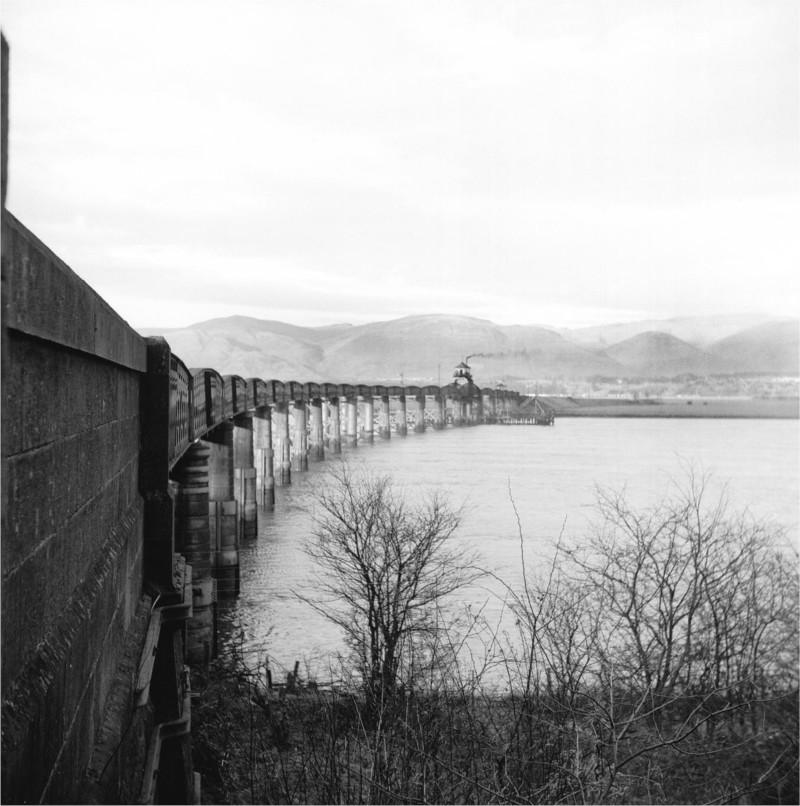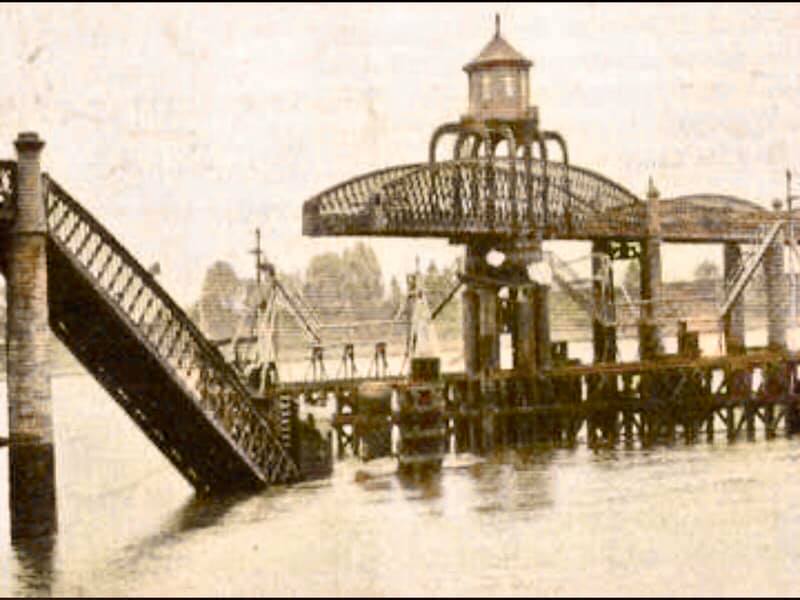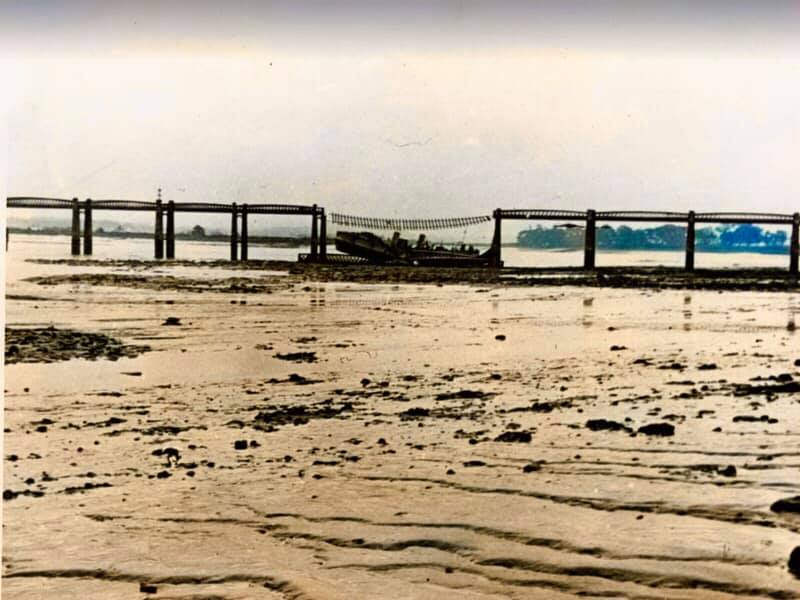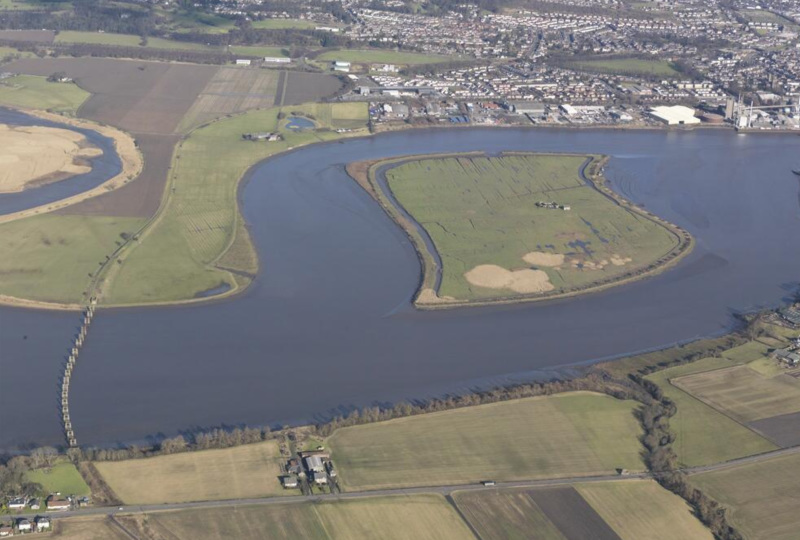The Alloa Swing Bridge was a railway swing bridge across the River Forth that connected Throsk and Alloa as part of the Alloa Railway. The structure was in use from 1885 until 1968.
The Alloa Railway obtained authority through an Act of Parliament on the 11th of August 1879 to open a section of line linking the South Alloa Branch of the Scottish Central Railway to Alloa. The new line was also connected to the North British Railway between Alloa Railway Station and Alloa marshalling yard - both opened on the 1st of October 1885. The rail line was double track except for the bridge crossing, which was single track. The swing bridge design was necessary to allow the passage of shipping up and downstream at a time when Stirling was still an active port.
The bridge was designed by the consulting civil engineers, Crouch and Hogg, and built by contractors Watt and Wilson, both of Glasgow. The bridge was designed as a 492 metre long (1,615 feet), with 20 spans made of wrought-iron with a bow-girder structure, with a horizontal curvature of 865 metres. The span of the swing bridge was 44 metres, providing a clear opening of 19 metres for river vessels on each side of a steam-powered, rotating, central pier that housed a cabin structure mounted over the rails to allow operation of the steam engine, which had been built at St Rollox works in Springburn, Glasgow. The central pier of the rotating span was protected by a timber cutwater that projected 43 metres up and down river. When the swing bridge was opened for river traffic, the ends of the rotating span were supported by structures at each end of the cutwater. The deck of the bridge was at a level of 7 metres above high-water level and was supported on piers, each consisting of two stone columns connected by ironwork at top and base.
Several aerial and deck level photographs of the bridge that illustrate the layout of the structure are available from the Royal Commission on the Ancient and Historical Monuments of Scotland (RCAHMS) and via canmore.org.uk.

Picture taken on final day of services, 29th January 1968 - View north from Throsk - Image via https://canmore.org.uk/collection/605746
The bridge was damaged by collisions on at least three occasions. In 1899, gales drove a sailing ship against one of the piers. On the 12th of October 1904, the schooner 'Stirling' under tow, also collided with one of the piers as it passed through the swing span, destroying the pier and displacing some girder spans. Rail traffic was suspended until the 1st of June 1905.

Damage to Bridge - internet image
In the early hours of Sunday the 15th of August 1920, an obsolete British destroyer, 'HMS Mallard', which was scheduled to be broken up, broke free from its moorings in a storm and was blown into the bridge. For some time this was widely reported in the local press to have been a former German warship. The damage was serious enough to close the bridge to rail traffic until the 1st of March 1921. HMS Mallard was a two-funnel (later D-Class) destroyer, launched in 1896 at Chiswick. Following her WWI Royal Navy career, Mallard was sold on the 10th of February 1920 to the Alloa Ship Breaking Company for breaking.

Mallard beside the damaged Alloa Swing Bridge 1920 - internet image
As a result of these incidents, three stone piers were replaced by cast iron ones and additional cross-bracing was added to all piers. Repairs were carried out by Sir William Arrol and Company.
Throughout its existence the bridge had carried passenger and freight traffic, but both gradually declined and in the 1960's, the passenger service was replaced by a four-wheeled railbus. Trains continued to bring coal to the swing bridge engine house until this was fixed in the open position for river traffic in May 1970. The connecting lines, bridge deck spans and engine house were dismantled and removed in 1971 and 1972, leaving only the piers and abutments, which remain in place as of 2022.

Modern image of dismantled bridge (left of picture) - Image via https://canmore.org.uk/collection/1272764
In May 2021 there was a proposal put forward within the local council to rebuild the bridge spans for use as a pedestrian path and cycleway.
